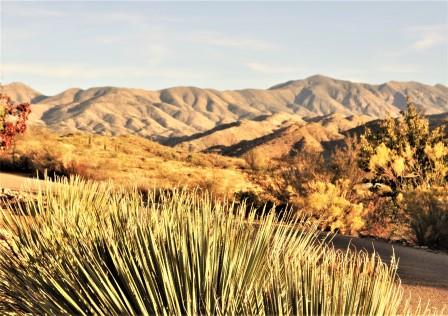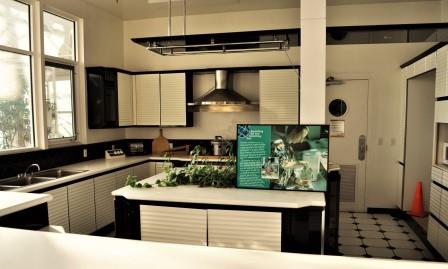The complete article was published in Travel Awaits on June 25, 2021
This post summarizes the five reasons to visit Biosphere 2 in the small town of Oracle, Arizona in the foothills of the Santa Catalina Mountains at an elevation of 4,000 feet. "As an American earth system science research facility built to be artificial, closed ecological system and designed to prove the viability of such systems to support human life in outer space, it is today still the largest such closed system ever created."
1. The Impressive Glass Pyramid
"Right after passing the many casitas, a café,
and other facilities that comprise a sizable Conference Center, you will be
impressed by a huge glass pyramid. You have reached Biosphere 2...That glass pyramid was created
to mimic Biosphere 1 (our Earth). It was an amazing venture constructed between
1987 and 1991, funded by the Texan billionaire and philanthropist Edward Bass
who put in $250M."
2. Six of the Seven Biomes
"Seven biomes were created to be jointly housed under that glass pyramid. The five ecological systems included are a 20,000 square-foot tropical rainforest, a 9,100 square-foot coral reef ocean, a 4,800 square-foot mangrove wetland, a 14,000 square-foot savannah grassland, and a 15,000 square-foot coastal fog desert. It was amazing to see the widely different kinds of plants supported by all those ecosystems under one roof. They used to support animals, too."
"In addition
to these five biomes, there is a 27,000 square-foot agricultural area
constructed to study the interactions between man, farming, technology, and
nature. And a new Lunar Greenhouse, a second prototype of the Controlled
Environment Agriculture Center, seeks to understand how to grow vegetables on
the Moon or Mars by developing a life support system that recycles water
through plant transpiration (sweating)."
3. The Seventh Biome: Biospherians’
Apartments
"The seventh biome is the human habitat. The first closure experiment was conducted from 1991 to 1993 involving eight humans, four men, and four women, called "Biospherians... There were problems encountered, including the split of the Biospherians into two factions and the power struggle over the management and direction of the project. Still the project was considered successful with world records set in agricultural production, health improvements, and insights into closed ecological systems."
Another experiment was conducted in March 1994 "with a crew of seven....but this also ended prematurely (after six months) with tensions in the management and financing of the project. This
second closed experiment, however, achieved total food sufficiency and did not
require the injection of oxygen, unlike the first."
4. The LEO, Landscape
Evolution Laboratory
"In 2007, the University of Arizona took over the research part and, with the help of private donations and funding, in 2011, full ownership...They added the LEO, the Landscape Evolution Observatory, which uses almost two thoeusand sensors to monitor millions of pounds of volcanic rock. It was built to track how this nonliving soil slowly develops over several years into rich soil by supporting microbial plant life. Three large steel-framed and glass-enclosed "hillsides" inside the pre-existing domes were built as the world’s largest device to measure the amount of actual transpiration (sweating) by plants."
5. The Technosphere Below and Outside
All that you see above ground is amazing but wait until you inspect what is below ground!"There are more than two dozen air-handler units that control air temperature and humidity, allowing for cooling, heating, water condensation, and dehumidification. Air is circulated to the air handlers from the Energy Center housed in a building external to the glass-enclosed area...Water from condensation within the biosphere is collected in a 200,000-gallon tank where it can later be used for other purposes like putting out a fire. The natural gas energy center supplies Biosphere 2 with electrical power with backup generators. There are also systems of solar panels throughout the grounds...Biosphere 2 also contains a biologically based waste-treatment system."
"But what interested me the most are the two large aboveground domes that contain what is called the 'lungs.' As external temperatures rise and fall, air remains trapped or is released from it. This release produces pressure that may exceed the strength of the glass, if not controlled. So the lungs are large expansion chambers that regulate the air pressure above. It consists of a heavy metal plate attached to a rubber membrane which is made to move up or down. Each lung is connected to the biosphere by a tunnel. It was so interesting to witness!"
FOR THOSE ON MOBILE, SHARE BUTTONS APPEAR WHEN YOU CLICK WEB VERSION AT THE VERY END AFTER COMMENTS.








This is so worth the visit! We take our guests to see this. We have been here three times!
ReplyDeleteThat seems interesting. It reminds me of when we went to a behind the seeds tour at Disney's Epcot to learn all f the innovative growing techniques they use for the foods they serve there in the restaurants.
ReplyDeleteThis is the real thing!
DeleteVery interesting. This reminds me of Gardens by the bay in Singapore. Of course, it is much bigger and built as a tourist attraction. Have you been there? I have never heard about any of these you have mentioned above. Thanks for sharing.
ReplyDeleteThis is all enclosed!
DeleteThis is an absolutely fascinating project. It needs projects like this to conserve the environment.Glad to see that they are doing something like this also in the US.
ReplyDeleteOnly one in the world!
DeleteThis is such an incredible place to visit! It's amazing that people have actually lived there, as part of the experiment. It's amazing that inside the ecosystem there are so many different environments. I would so be curious to see the fog desert.
ReplyDeleteIt was spring inbthe desert when we visited.
DeleteI wish I had read your article before visiting Tucson. Because I had not heard about Biosphere 2 and missed it on my last trip. I'd like to see Landscape Evolution Laboratory and learn more about one of the world's strangest experiments.
ReplyDeleteMust-see!
DeleteMy family is fascinated with all things sci-fi so this is right up our alley! This reminds me of The Land ride at Epcot....or really all of Future World at Epcot! I'd love to visit and check it out. Thanks for the info!
ReplyDeleteExcited is make-believe. Th is is reall.
DeleteI am sorry we missed a visit to Biosphere 2 when we stayed in Tucson. I love the idea of an App for a guided tour. How interesting to see the different biomes. Great to learn more about how this complex environment is maintained.
ReplyDeleteWhen you get back!
DeleteOh I've read about these experimental biospheres! I didn't know any were open to visit, definitely one to add to the list for our next trip to Arizona. I particularly like that they provide an app-based self-guided tour.
ReplyDeleteThis is the only one!
DeleteI saw the sign to Biosphere 2 when we left Tucson for the Grand Canyon. I really wanted to experience this, but we didn't have more time to spare during our road trip. Thank you for taking me to tour the mimic earth. One day I will see it myself.
ReplyDeleteNext time@!
DeleteFor people of all ages, this is a must-see attraction. This article inspires me to learn more about Earth Science Experiments and conduct additional research. Thank you to everyone who has contributed to this experiment. Excellent learning opportunity!
ReplyDeleteYes, I was inspired, too!
DeleteI visited Biosphere near Tucson several years ago but I remember it as a large dome. I took a guided tour but love when attractions have apps for self guided tours. Hearing the stories of the people who lived there was interesting
ReplyDeleteIt has expanded with the Landscape Evolution Laboratory!
DeleteThe Biosphere 2 is an amazing place to visit. The different biomes created with respect to the ecological system is a wonderful scientific achievement.The evolution laboratory and the large external lungs created to store gases is an amazing feat.
ReplyDeleteIt was amazing to see and learn about.
DeleteThis sounds such an interesting project. Very informative an article I had not much clue about. The glass pyramid would be nice to explore.
ReplyDeleteYes...we have been to it 3x!
DeleteI would definitely be excited to visit the glass pyramid Biosphere 2. Good tip to download the app for a guided tour. I too would find the above ground “lungs” to be fascinating.
ReplyDeleteHope you can see it in person!
DeleteWow! You really did your research! I love anything that has to do with nature, preservation, and how we can use it for the future. Space colonization is so fascinating and I think we as a society will get there one day.
ReplyDeleteI think so too!
DeleteMy undergraduate area of study was biology, so this seems like an awesome travel destination. Will certainly pay a visit my next trip to Arizona.
ReplyDeleteVery interesting read. Love how you did your research and makes me want to visit one day. Love the nature aspect!
ReplyDeleteThanks for the compliment!
Delete